|
|
Greetings!
Our staff has spent some time recently talking about our New Year’s resolution to “stop starting and start finishing.” Among the things we have made good progress on are:
- Constructing a one-stop data warehouse for fishery and resource survey data
- Developing a new deepwater longline survey in the South Atlantic, expanding partnerships in the Gulf, and modernizing our research surveys with automated image analysis and other advance technology
- Updating our fish stock assessment process to be more efficient
- Transferring some of our stranding and response efforts to regional partners in order to prioritize in-water monitoring of protected resources
- Continuing to integrate social sciences into the mainstays of our mission
- Completing the U.S. South Atlantic Ecosystem Status Report
- Finalizing the Gulf of Mexico Marine Assessment Program for Protected Species products
- Maintaining our extensive passive acoustic monitoring network in the Gulf to understand how ambient noise levels may impact whales
We also will be focusing on meeting the administration's objectives to integrate climate science with fisheries and protected species assessments and better understand the effects of climate change on the ecosystem (think harmful algal blooms, coral bleaching, etc.).
I’m also proud to highlight more of our fantastic team at the science center. Read more below about some of our staff as part of the Faces of the Southeast Fisheries Science Center web series.
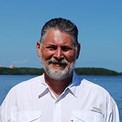 |
|
Thanks for your continued support and interest,
Clay Porch, Ph.D
Southeast Fisheries Science Center Director
clay.porch@noaa.gov
|
|
|
Go Slow, Whales Below
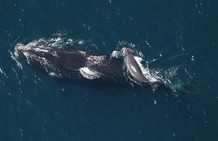
North Atlantic right whales are approaching extinction with fewer than 350 remaining. With so few of these whales left, researchers closely monitor the southeastern United States for new offspring during the annual right whale calving season. Meet the newest mothers and calves.
|
Citizen Science Helps with Rare Sailfish Recaptures
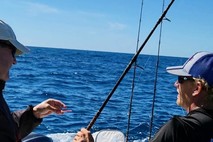
Over the last 10 years or so, approximately 8,500 sailfish in the Atlantic have been tagged. NOAA works with other organizations and many volunteers to tag sailfish and other highly migratory species, including tunas, swordfish, and other billfish. We depend on the fishing community, tournament operators, and other participants to report any recaptures. Read more about a rare occurrence of two sailfish being recaptured at about the same time.
|
Two-track Approach Will Incorporate Gulf State Recreational Fishing Data Into Federal Stock Assessment, Management Process
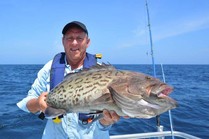
At a recent workshop, NOAA Fisheries and its Gulf of Mexico partners agreed to pursue a two-track transition toward incorporating state recreational catch estimates into the federal stock assessment and management process. Statistical calibrations will allow data from state surveys to inform upcoming stock assessments. Short- and long-term research priorities will address congressional directives to review and identify improvements to state and federal surveys.
|
|
|
Meet Corinne Paterson, Research Associate
 |
|
Corrine is a Senior Research Associate for the Cooperative Institute for Marine and Atmospheric Studies. She works in the Marine Mammal Molecular Genetics Laboratory as a lab technician. There she uses various genetics techniques to answer questions about marine mammals in the western north Atlantic and Gulf of Mexico. Meet Corrine. |
Meet Keeley Belva, Communications Manager
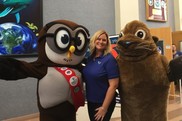 |
|
Keeley started working at the science center in March 2021, but has been with NOAA for almost 20 years. As the communications manager for the science center, she gets the opportunity to tell people about the important work that the science center team does. Some days that means working with news media, some days it means creating web content and writing this newsletter. Meet Keeley. |
Meet Michelle Duncan, Fisheries Education Specialist
 |
|
Michelle assesses spawning for various species of snappers and groupers to determine maturity and assists with population assessments. She also works on educational research to understand barriers related to diversifying marine science and NOAA’s scholarship programs. Meet Michelle. |
Meet Trika Gerard, Chief of Staff
 |
|
As the Chief of Staff Trika manages the day-to-day operations and responsibilities of the center’s directorate office. She is a strategic advisor to the center's leadership team who often works behind the scenes to problem solve any issues before they are brought to our director. Meet Trika. |
Meet LaGena Fantroy, Librarian
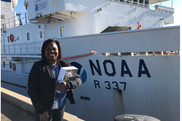 |
|
LaGena's library support includes expanding digital resources such as ebooks and audiobooks for field research. She also helps with bibliographic support and journal subscriptions, and she also participates in NOAA’s Fisheries Education Council. Meet LaGena. |
Meet Mal Brassfield, Network Manager
 |
|
Mal currently specializes in network management for the center. Since bringing internet connections to the center in the 1990s, he has installed and maintained software and network equipment that has become instrumental for our communications. Meet Mal. |
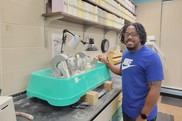 |
|
Naeem is a Senior Research Associate for the Cooperative Institute for Marine and Atmospheric Studies. His main focus is sectioning and aging fish otoliths, or ear, bones to determine the age of the fish. Age data is used to help gain a better understanding of fish populations so we can monitor and manage the species. Meet Naeem. |
 |
|
Lisa originally started at the science center as the Director of the Pascagoula laboratory. Today, she is the Deputy Director for Science and Operations. She oversees divisions focusing on activities such as facilities, IT, administration, and budgeting, as well as some of our science programs. Meet Lisa. |
|
|
|
The mission of NOAA's Southeast Fisheries Science Center is to provide the scientific advice and data needed to effectively manage the living marine resources of the Southeast region and Atlantic high seas.
Visit our website
|
|
|
|